The London Stereoscopic and Photographic Company, 1854 – 1922
last updated May, 2016
Primarily a photography studio and retailer of photographic
equipment and supplies, the London Stereoscopic and Photographic Company (LSC)
also sold items related to microscopy and other Victorian pastimes. Microscope
slides from that era are occasionally found that bear a yellow LSC label. The
majority of these were produced by professional slide-makers, with their
personal labels (Figure 1). It is not known whether those makers intentionally
retailed through LSC or if the company re-sold used slides.
However, one slide appears to have been produced
specifically for LSC, in 1868 (Figure 2). Several identical examples of this
mount are known, indicating that it was not a one-off. The bright blue-papered
slides bear the handwriting of esteemed professional Charles Morgan Topping.
LSC also sold microscopes (Figure 3). To judge from the
emphasis of LSC on photography, these instruments were almost definitely bought
for resale from outside manufacturers.
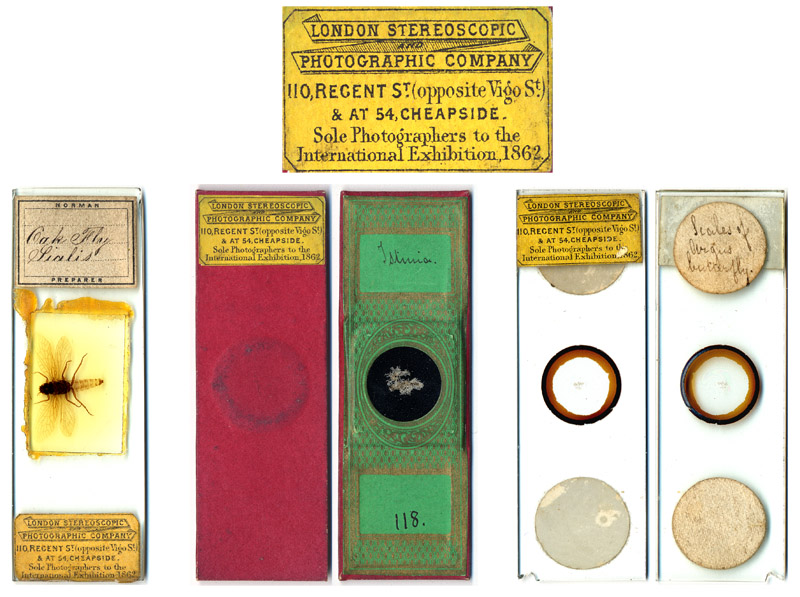
Figure 1.
Examples of microscope slides sold by the London
Stereoscopic and Photographic Company. The left slide was produced by
professional slide-maker John T. Norman. The center is from the unidentified
prolific mounter nicknamed “Greenpapers”. Other slides by the maker of the
right slide are moderately abundant, most of which do not have an LSC label.
The only known form of the LSC label states addresses of 110 Regent Street and
54 Cheapside, even though they are known to have been applied to slides sold
after the business expanded to other addresses (see Figure 2). Thus, LSC labels
do not specifically date slides.
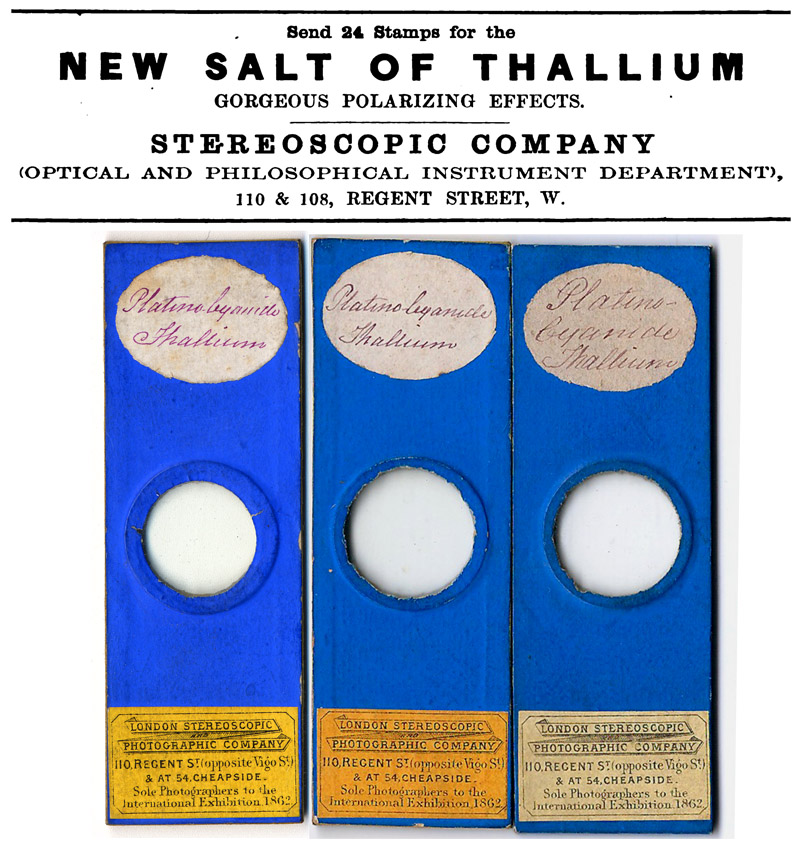
Figure 2.
Microscope slides that appear to have been produced
specifically for LSC. The handwriting is that of professional slide-maker Charles
M. Topping. Advertisements for this slide of platinocyanide of thallium began
appearing in 1868. This was after the Regent Street shop had been expanded to
include both numbers 108 and 110. Note that the label mentions only the 110
Regent St. address (plus their other location at 54 Cheapside).
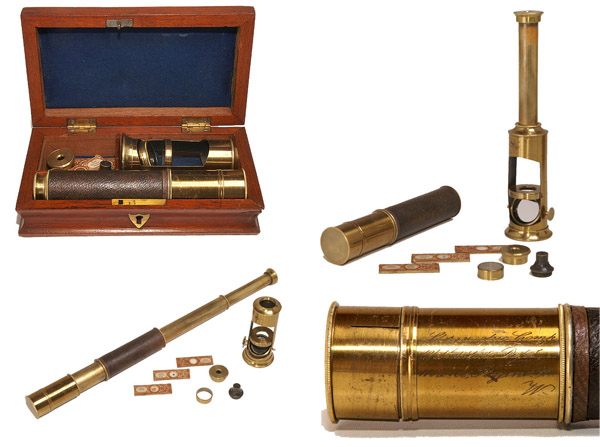
Figure 3.
A combination microscope / telescope, engraved
“Stereographic Company, Optical Dept., 110 & 108 Regent St., W”. Images from an internet auction.
The LSC produced a considerable number of other, quality
items throughout the second half of the 19th century, and into the 20th. Photographs and stereoscope cards from LSC can frequently be
found at reasonable prices and in good condition. Their cameras and lenses were
well regarded, and can often be found in good condition at auctions. Following
is a brief history of the LSC, along with illustrations of their products
(generously provided by various collectors). Additional examples of LSC
productions and historical insights can be seen at Brian May’s tribute to the
LSC and stereoscopes, http://www.londonstereo.com/.
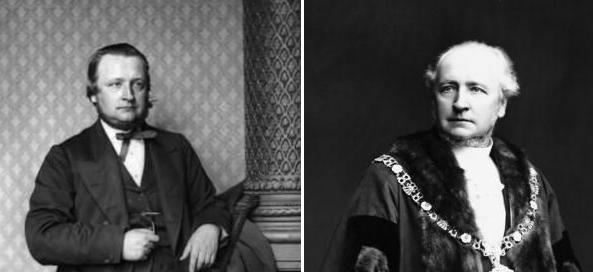
Figure 4.
Undated photographs of George Swan Nottage, the
founder of London Stereoscopic and Photographic Company. The right photograph
shows him in his garb as Mayor of London. Original sources not known, used here
for nonprofit, education uses.
The LSC was founded by George Swan Nottage (1823-1885), in
partnership with his cousin Howard John Kennard (1829-1896). Nottage was described by J. Solomon as “a descendant of a very humble family, died
Lord Mayor of London”. Nottage was elected Alderman of London in 1875, Sherriff in
1877, and Mayor in 1884.
Nottage opened a shop at 313 Oxford Road, London in 1854, to
sell iron bronzes from Kennard’s foundry. Nottage placed some continental paper
stereoviews in the window, which sold so well that they replaced the bronzework
as focus of the shop. As it developed through the years, the business was
variously known as The Repository of Art, The London Stereoscope Company,
Stereoscopic Corporation, and the London Stereoscopic & Photographic
Company.
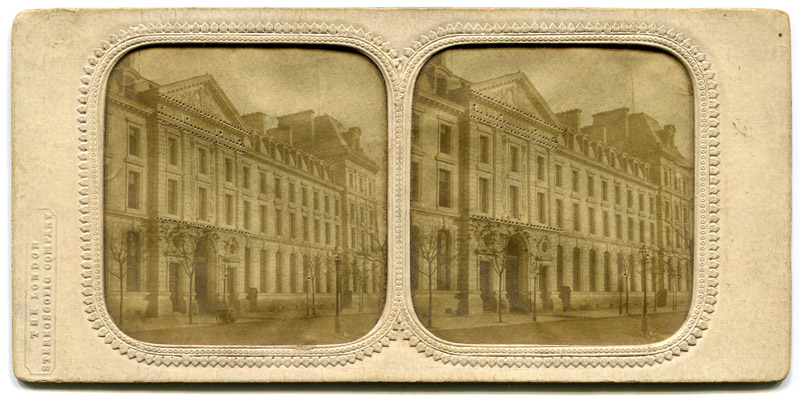
Figure 5.
A tissue stereoview of the Palais Royal, Paris, and
blindstamped “The London Stereoscopic Company”. French imports such as this
were the first stereoviews sold by Nottage. Tissue stereoviews were printed on
translucent paper, often with pin-pricks and colored paint on the reverse. They
resemble normal photographs when viewed with front light, but when viewed with
back light, the light shines through the pin-holes and colors become visible.
The
following year, The Art Journal reported
“Improved Stereoscope - We had the
pleasure of examining, a short time since, at the
Repository of Art, 313, Oxford Street, some
improvements which have recently been made in these instruments. The great
defect hitherto existing has been in their not being adapted to varied sights.
This is now overcome by a simple contrivance, which consists of a central screw
which heightens or depresses the eye-pieces to suit the sight of every
observer. This improvement renders Sir David Brewster's invention perfect. Some
views taken by the artists of the company were the finest in tone and sharpness
that we ever saw”.
Also in
1855, Nottage devised a clever advertisement for his business, in the form of
an essay competition. Applicants were requested to submit essays on the “stereoscope”. The judge was David
Brewster (1781-1868), the inventor of the stereoscope (Figure 6).
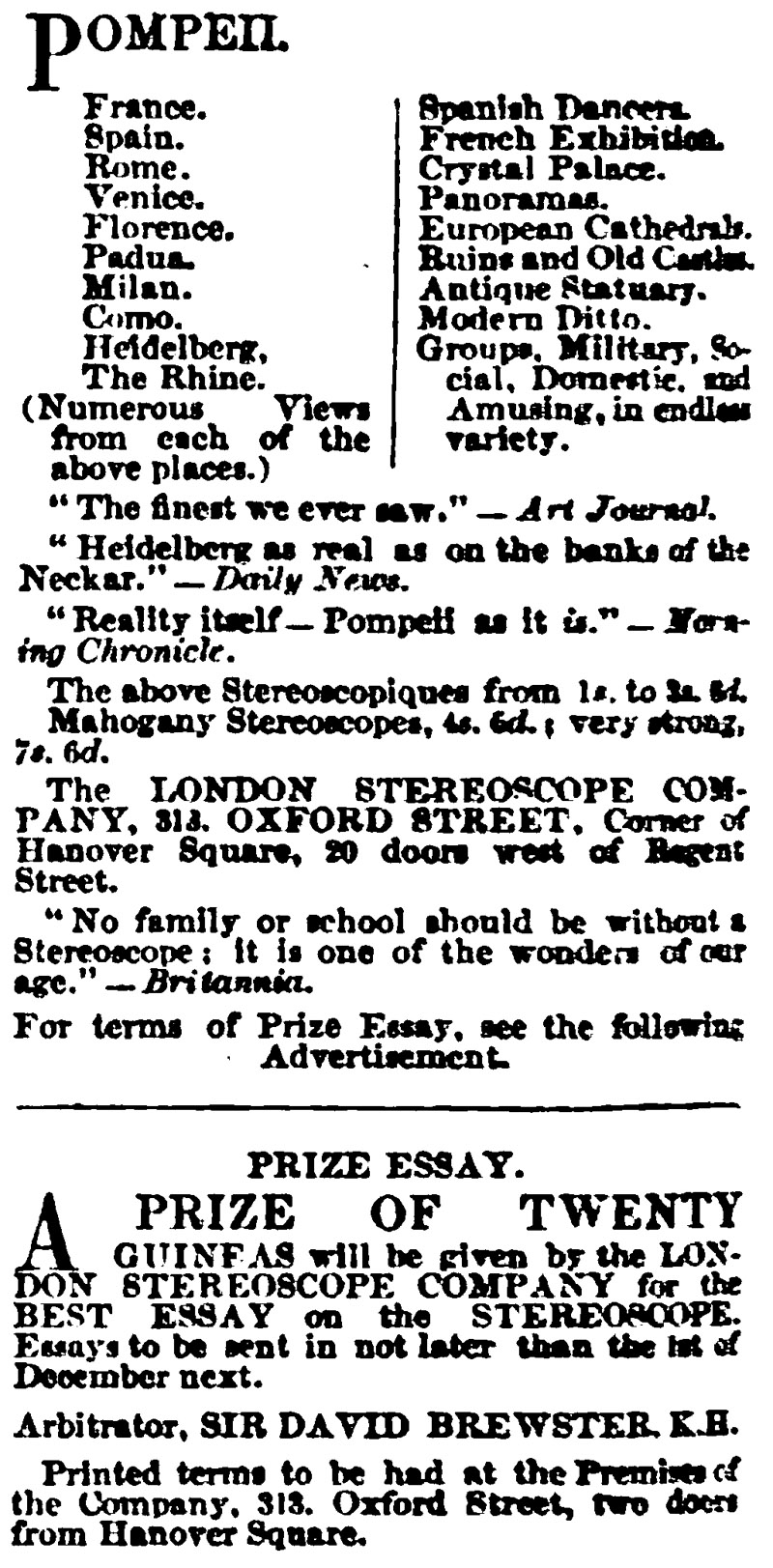
Figure 6.
Advertisements for the London Stereoscope Company,
from “Notes and Queries”, 1855.

Figure 7.
By January, 1856, LSC had opened a second shop
at 54 Cheapside. I have not located any advertisements that mention the Oxford
Street address after 1858, suggesting that the initial shop had closed by the
end of that year.
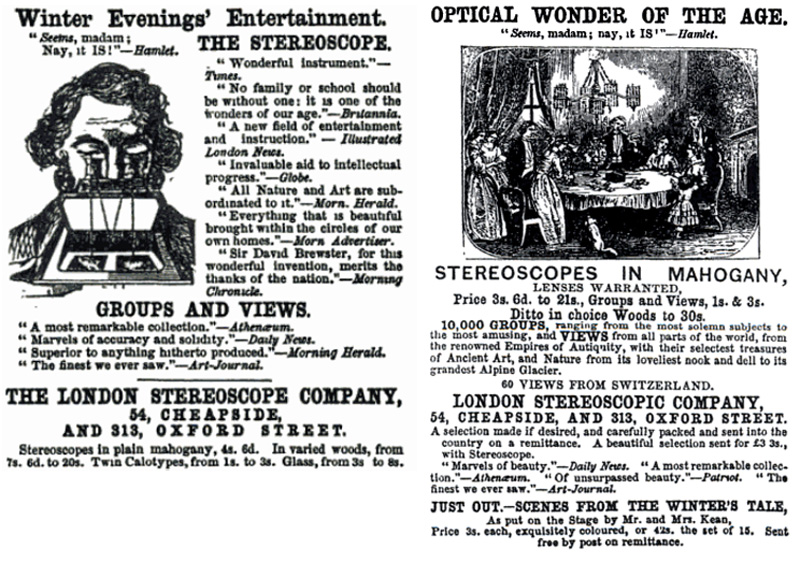
Figure 8.
Ca. 1856-58 advertisements from the Art Journal, after the LSC had opened its shop at 54 Cheapside.

Figure 9.
Advertisement from the November 19, 1858, issue of The Photographic News.
The new location at 54 Cheapside included studios for
taking photographs. It was becoming fashionable to have small cards bearing
one’s photograph, to leave as a calling card, the “carte de visite”, or CDV. Two 1861 advertisements from the Athenaeum:
‘The finest we ever saw.’ Art-Journal.
THE LONDON STEREOSCOPIC COMPANY, 54, Cheapside (2 doors from Bow Church),
have made a reduction of 40 per cent on the West-end prices of the above. By
friends exchanging these charming portraits each is enabled, by such exchange,
to have a large group of his friends upon his drawing-room table, and thus add
at a trifling cost another source of amusement to the social circle. The
Company simply invite an inspection. The pictures will be arranged and
photographed by an eminent Foreign Artist, whose services the Company have
recently secured. All the celebrated men of the day can also be supplied in the
above style. Private Entrance, Bow Churchyard, where Carriages can wait.”
‘None are superior to those of the London Stereoscopic Company.’ Art-Journal Review.
‘Theirs are the finest.’ Photographic News Review.
As the best Makers have now
exhibited all their Summer Pictures, and the palm of superiority having been
awarded to the Company, though their Pictures were taken in November and
December, the Public can now decide where they can obtain the highest quality. Price, 10 for 10s, or 21 for 20s. 54, Cheapside, two doors from Bow Church. Private
Entrance, Bow Churchyard, where Carriages can wait.
French, Italian, German, Russian and Polish Languages spoken.”
CDVs of famous people, such as the Queen and her family,
politicians and actors/actresses were in high demand by collectors (see Figures
23, 26, 28 and 31). LSC advertised in February, 1861, that they, “have a large Collection of the most
Celebrated Persons in the World. Albums from 7s. 6d. each. The Trade supplied
on liberal terms”.
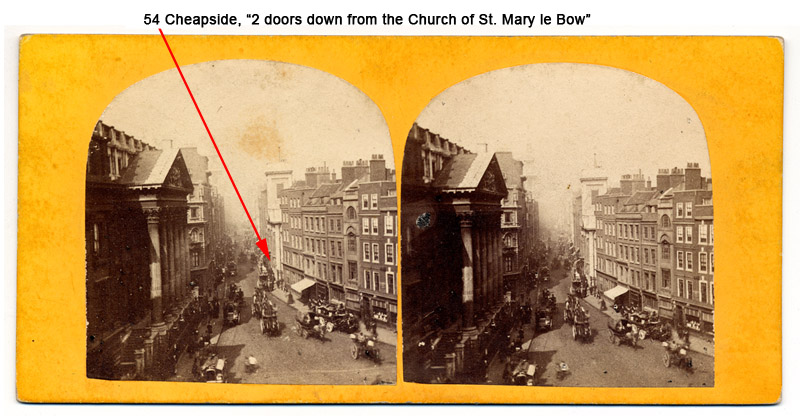
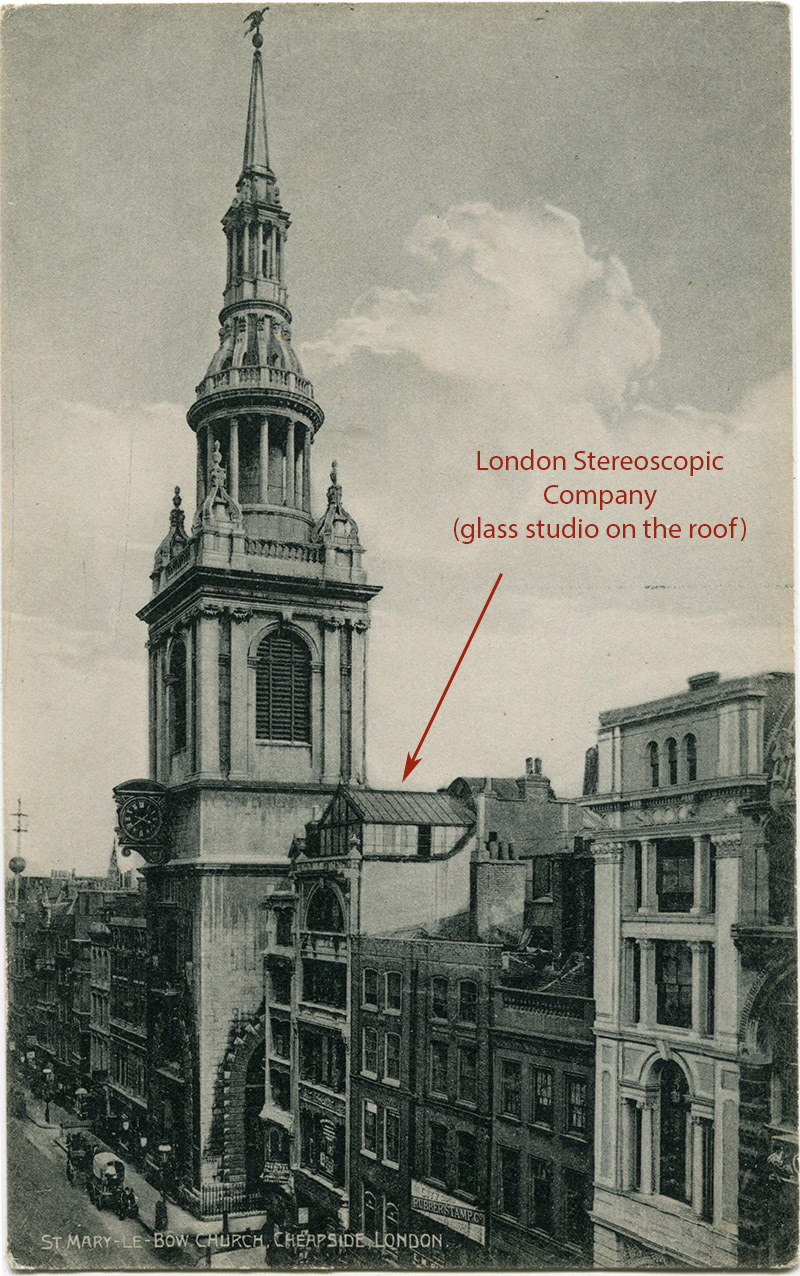
Figure 10.
Top, a stereoview of Cheapside. LSC was located at number 54, which, in this view, is just before the Church of Saint Mary le Bow, on the right side of the road.
Bottom, a ca. 1900 photographic postcard of Cheapside, produced by LSC. 54 Cheapside is two buildings before the church, on the right. The gable-ended, glass photographic studio on the roof is evident. There is an alley and courtyard between the white building beyond LSC and the church, which is mentioned as a parking space in advertisements.
LSC was the official photographer for the 1862 London
International Exposition. That opportunity resulted in significant profits for
LSC and Nottage. Photographer Joseph Solomon recounted, “There
was (a) man who amassed a large fortune from the pursuit of photography. He
early saw that photography would yield to anyone who followed it closely large
profits, and he opened half of a shop near Hanover Square with the
determination to make it pay. This man's name was Nottage.
He placed over the door ‘Stereoscopic Co.’, and exposed for sale
stereoscopic and other photographic pictures. His success was due largely to
the aid which clever photographic artists gave him at home and abroad. Among
these we may mention the names of Wilson, of Glasgow; England, of London; and Ferrier, of Paris. Nottage took a large corner house in Cheap Side, London -
erected on the top floor a studio for portraiture, and employed the best
manipulators in photography. When the Exhibition of 1862 was opened, Nottage was purchasing largely from Mr. England, and he
suggested to that photographer to offer a large sum of money to the managers of
the Exhibition for sole permission to take photographs of the buildings and on
the grounds, and also to erect a small building for the sale of photographs. He
obtained the permission and he shared the speculation with Nottage. From the day it was opened until the last day
the sales from photographs of the Exhibition amounted each day to £800, and at
one time to £1,400”.
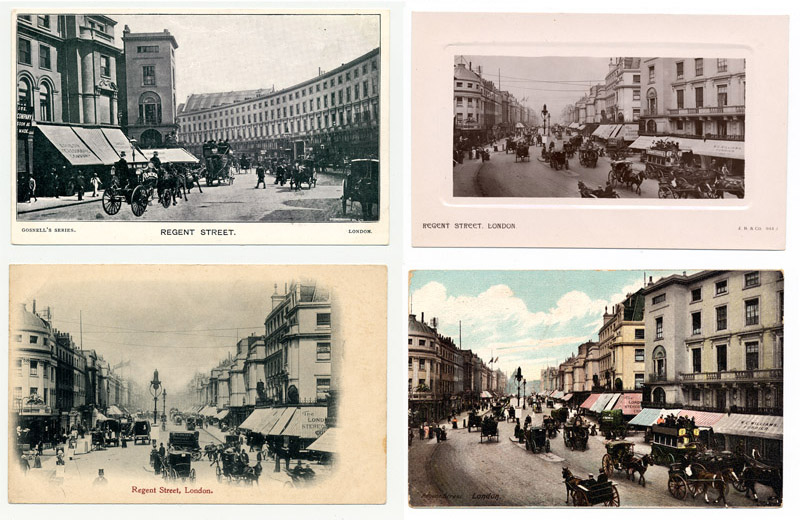
Figure 11.
Postcard views of the LSC Regent Street locations.
LSC expanded ca. 1862 to include a new shop at 110 Regent
street, in addition to 54 Cheapside. About 1866, the Regent Street site grew to
include both number 108 and 110. It expanded again about 1875 to include number
106, and about 1891 condensed to just 106 and 108 Regent Street. The Cheapside
location remained open through at least 1907. It is difficult to precisely date
LSC addresses from advertisements and notices, as such documents did not always
include every address.
A description of the business in 1891 read, “The new premises of the London Stereo. Co. on the sunny side of Regent street form so large a ‘novelty of the year’ as to require a separate description. The shop front is large and handsome, and a crowd of onlookers is ever engaged in studying the countless attractive photographs displayed, although the separate window full of ‘brass and glass’ in the form of highly finished cameras, lenses, etc., does not want its share of admirers.
Stepping inside we are received by the genial and
able manager of the apparatus department, Mr. Butler Humphreys, and take brief
notice of the immense stock of material carried by the company. A dozen, nay, a
gross of African explorers could be fitted out with the now indispensable
photo-equipment at the shortest notice; while of the photographs of notable
places and persons there appears to be no end.
A finely appointed lift connects all the floors; but
we prefer to ascend the broad staircase to the first floor, which contains a
magnificent reception room, crowded with enlargements, direct photographs (up
to 30x24 inches) and paintings, and most richly furnished. The second floor
contains stock rooms and repairing rooms; while on the third floor are a series
of luxurious dressing rooms. The fourth flour has a very large studio, with
special dressing room and dark room attached; and also an instruction room for
amateurs, and a series of dark rooms specially built for the use of amateurs
visiting town. Many of our best amateurs have been taught here. Finally, there
is a second large and capitally lighted and furnished ‘drawing room’ studio on the roof.
The building is lighted throughout with both the
electric light and gas. The former is continually used in the large studios;
and during the present season has been largely employed for ‘fancy ball work’
up to midnight. It is also requisitioned every evening to throw lantern slides
upon a sheet of ground glass seven feet square in the
first floor window facing Regent street. This forms an entertainment for the
passer-by; and also a first rate advertisement for the company.
The company has a second large establishment in London at 54 Cheapside, and here the energetic general
manger, Mr. Lillie Mitchell, is generally to be found. The general work here is
similar to that at Regent street, but the office work connected with the
photo-mechanical branches is mainly transacted in Cheapside.
The company's printing establishment is situated at
New Southgate, on the north of London, and outside
the pall of smoke and fog which so frequently overshadows the metropolis. Here
silver printing is done on a very large scale, an average of 200 sheets of
paper being sensitized per day. Toning is done with the acetate bath, and
mounting, with glue soaked in water and then dissolved by heat in methylated
spirit. Every print is washed in twenty changes of warm and cold water,
followed by twelve hours in running water. Carbon printing is also largely
practised; and for the Woodbury type process there are two hydraulic presses
capable of exerting pressures of 500 tons and 250 tons respectively. But
perhaps the most interesting feature at New Southgate is the photo-mechanical
printing; chiefly done by that perfected form of collotype which the company
has christened ‘photo-mezzotype.’ Eight large machines, each weighing twelve
tons and made in Germany take negatives of plate glass up to 36 inches by 30.
Upon some of these big slabs as many as thirty-six distinct negatives are
impressed and printed at once. Orders on an immense scale are continually being
executed for the great advertisers of the day; and all the boards for mounting
are made, and the letter press printing executed on the premises.
In conclusion we note that the extensive business
which we have had the pleasure of briefly describing
was originated by the late Mr. Nottage in 1850; and
that it owes its name of ‘Stereoscopic’ to the fact of his friendship with Sir
David Brewster, the inventor of the stereoscope. Alderman Nottage became Lord Mayor of London in 1884 ; and -
sad to say - died during his mayoralty. On
his death, the business was formed into a limited company; but in which the
founder's son, Mr. Charles G. Nottage, and his
partner, Mr. Howard J. Kennard, retain a principal interest.
The chief or distinguishing feature of the London Stereoscopic Company, Ltd., appears to us to be
the complete manner in which it embraces every branch of photography. Its
special operators are ready to start at a moment's notice to photograph
anything, anywhere. The apparatus department, the teaching staff, the artists
who reign in the studio, the hundred workmen and workwomen at Southgate, all
combine to impress us with the fact that we have really here a commercial
‘Photographic Institute’ of the highest class. We wish the company continued
and deserved success, for it is working in the best interests of photography
The London Stereoscopic Company continued in business until 1922.
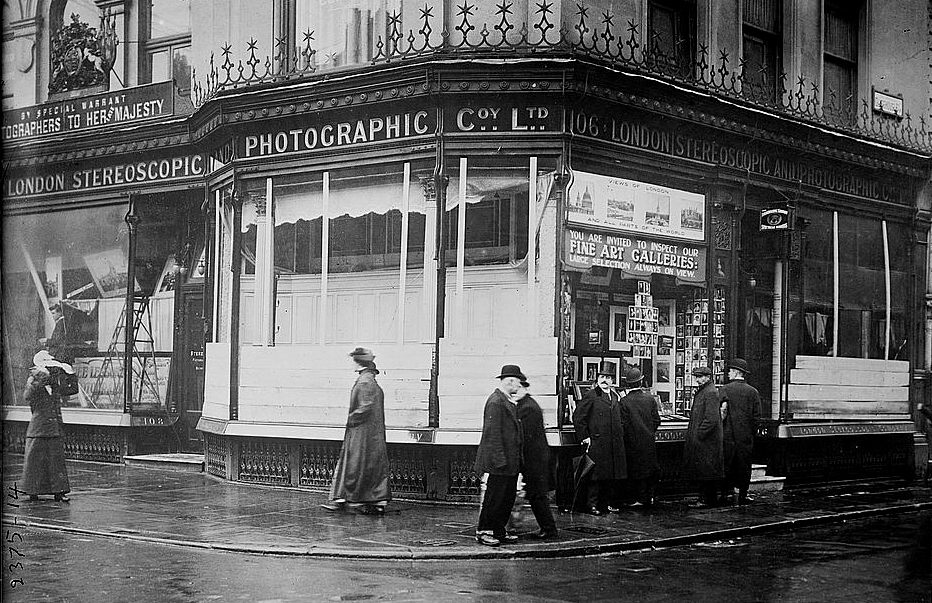
Figure 12.
March, 1912 of the LSC storefront at 106 Regent Street.
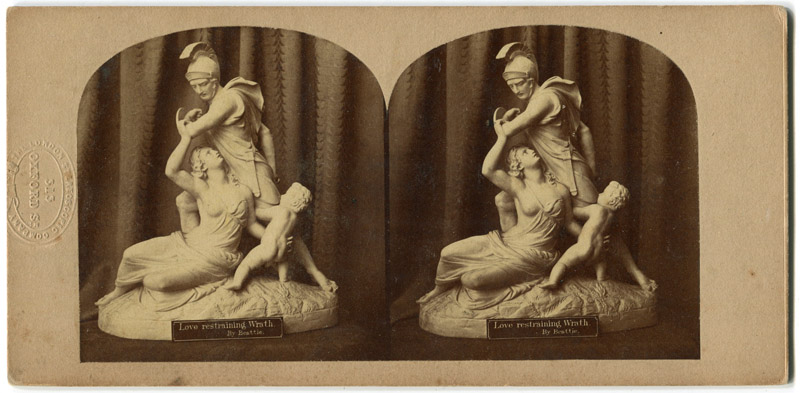
Figure 13.
A very early stereoview, blindstamped with the
address 313 Oxford Street. LSC was at this address alone between 1854 and early
1857. The subject is an 1851 sculpture by William Beattie, “Love restraining
Wrath”. Many of Beattie’s works were reproduced in porcelain by Minton for the
1851 Great Exposition.
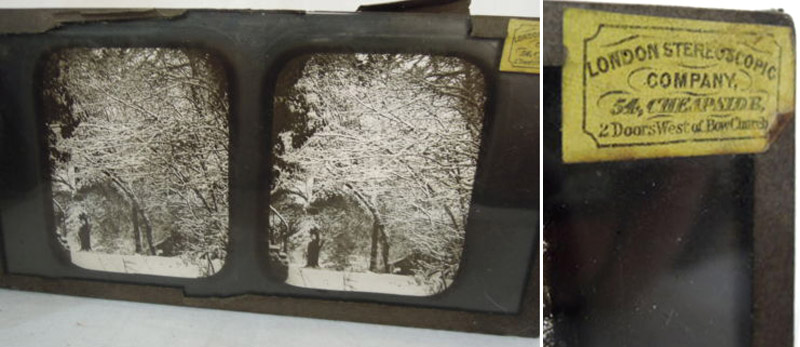
Figure 14.
A glass stereoview with a label bearing the address of 54 Cheapside, only. This probably dates this photograph to the time when LSC was located at only that address, 1857 until ca. 1862. Transparent photographs on glass were readily viewed through Brewser-type viewers (see Figure 18)
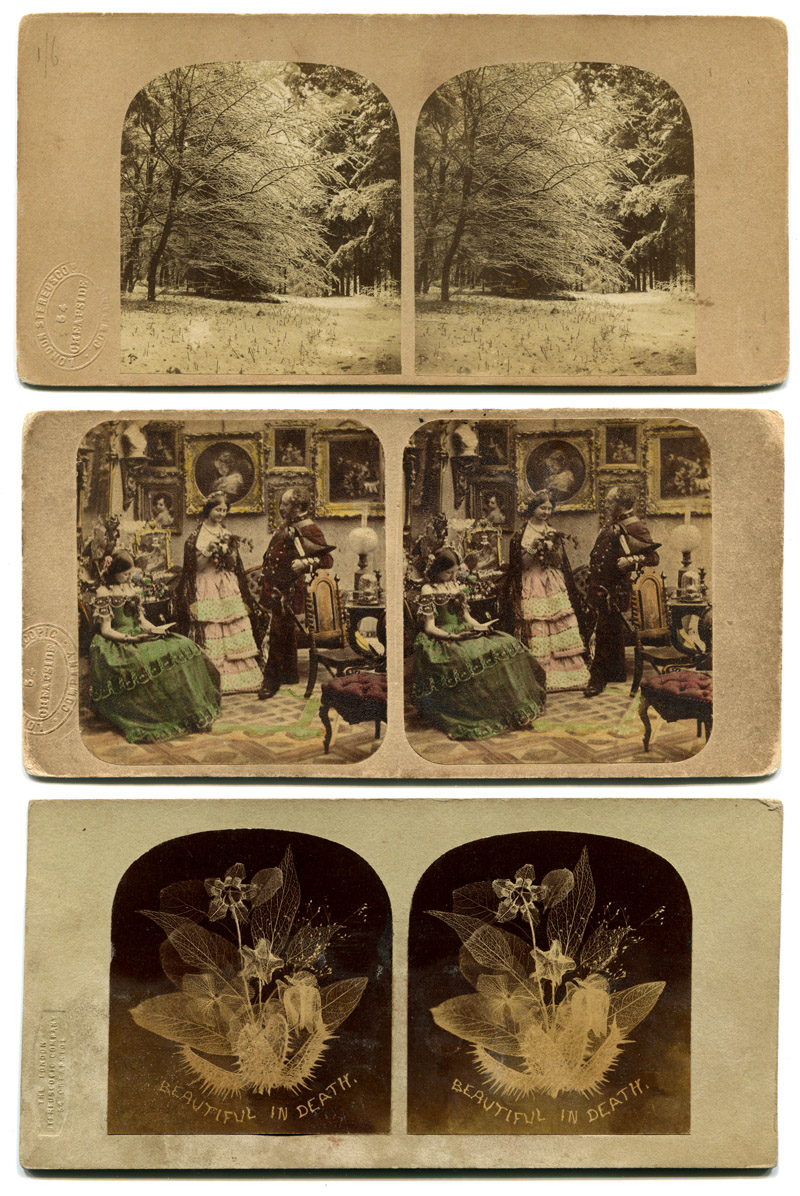
Figure 15.
Stereoviews blindstamped with the 54 Cheapside address, dating them between 1857 and ca. 1862.
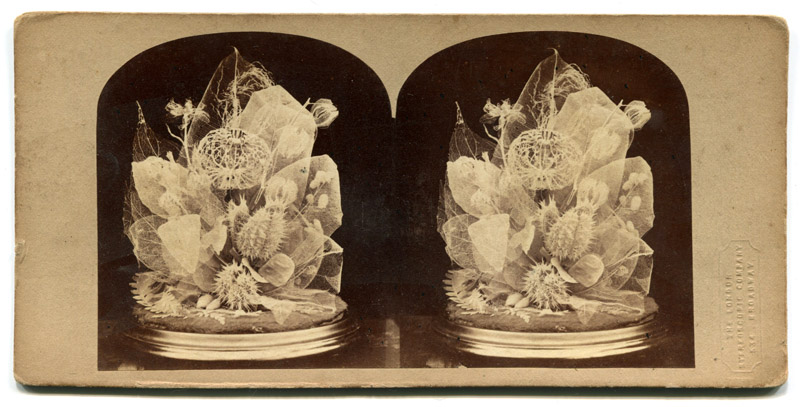
Figure 16.
LSC opened a branch in New York City in 1860. This stereoview has a blindstamp from that shop, at 594 Broadway, NYC.
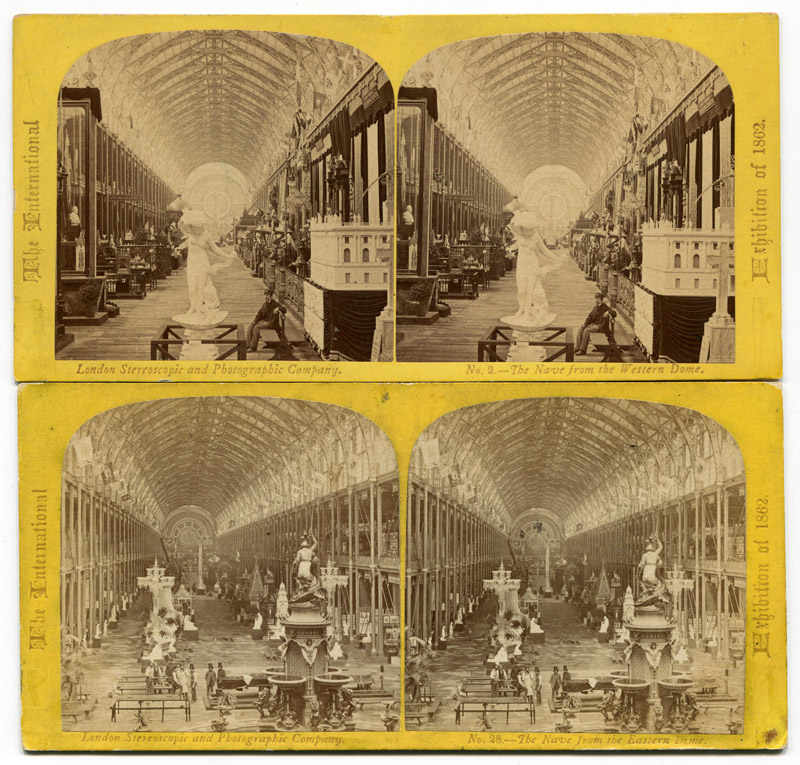
Figure 17.
LSC stereoviews of the interior of the 1862 London International Exposition’s Crystal Palace.
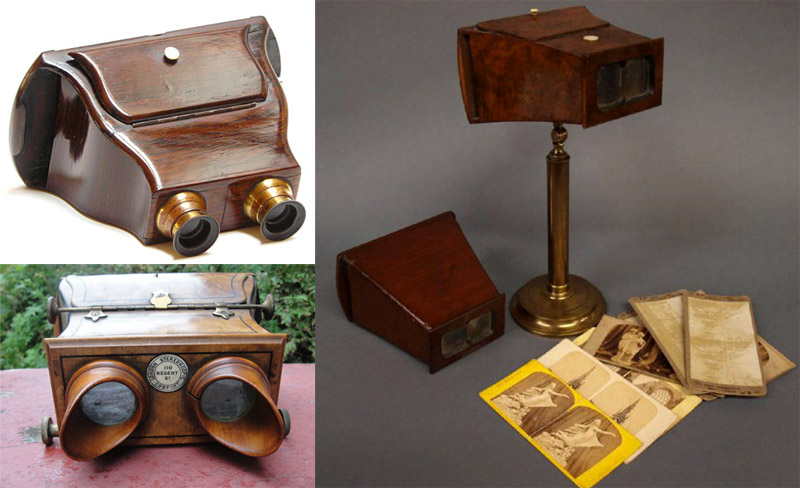
Figure 18.
Stereoviewers from the London Stereoscopic Company.
The viewer at the upper left and the one on the right both bear addresses of
313 Oxford Road, dating them to ca. 1854-1857. The lower left viewer is marked
110 Regent Street. Images from internet auction sites.
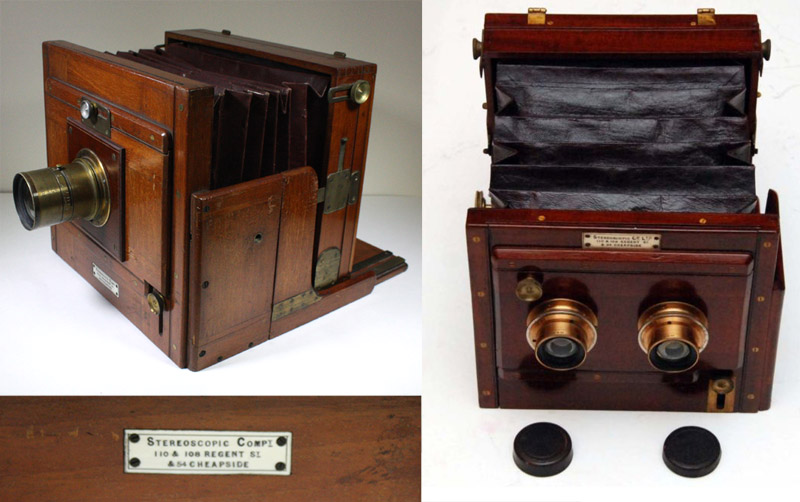
Figure 19.
Two LSC cameras, both marked 110 & 108 Regent
St. and 54 Cheapside, dating them to ca. 1866-1875. The right camera, with two
lenses, is set up to produce stereoscopic photographs. Images from internet
auction sites.
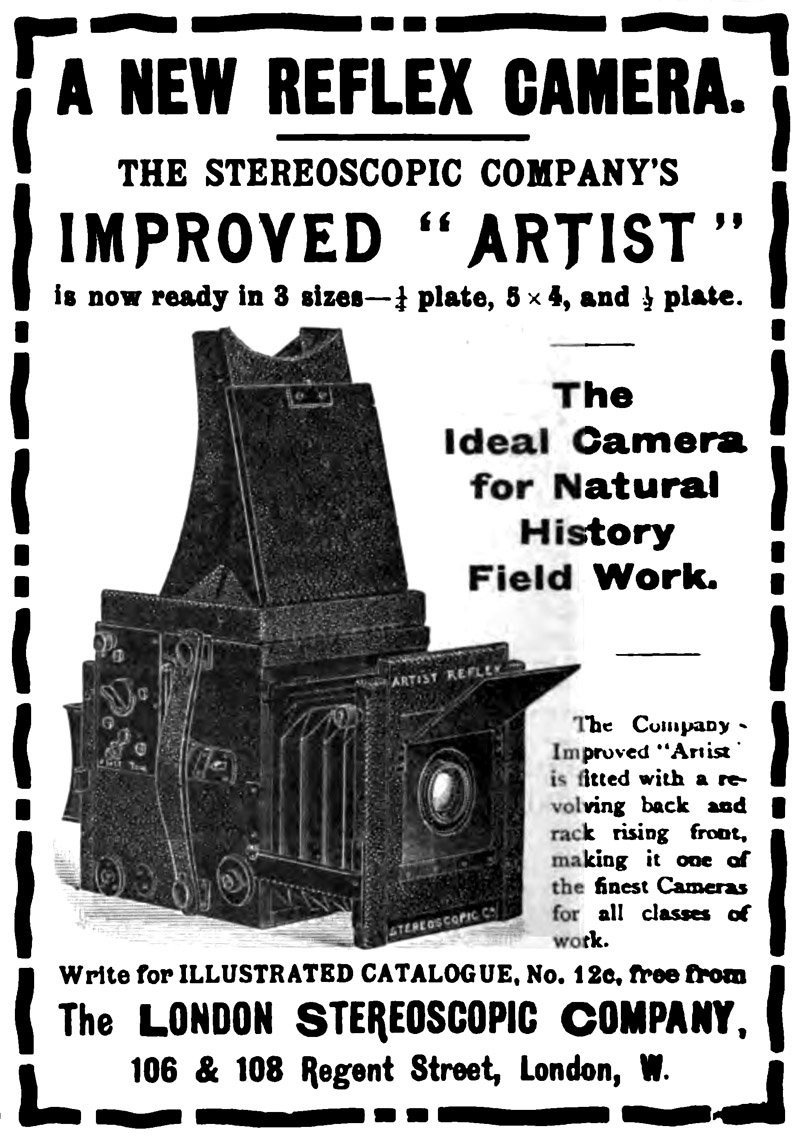
Figure 20.
Advertisement for a hand-held camera, 1908.
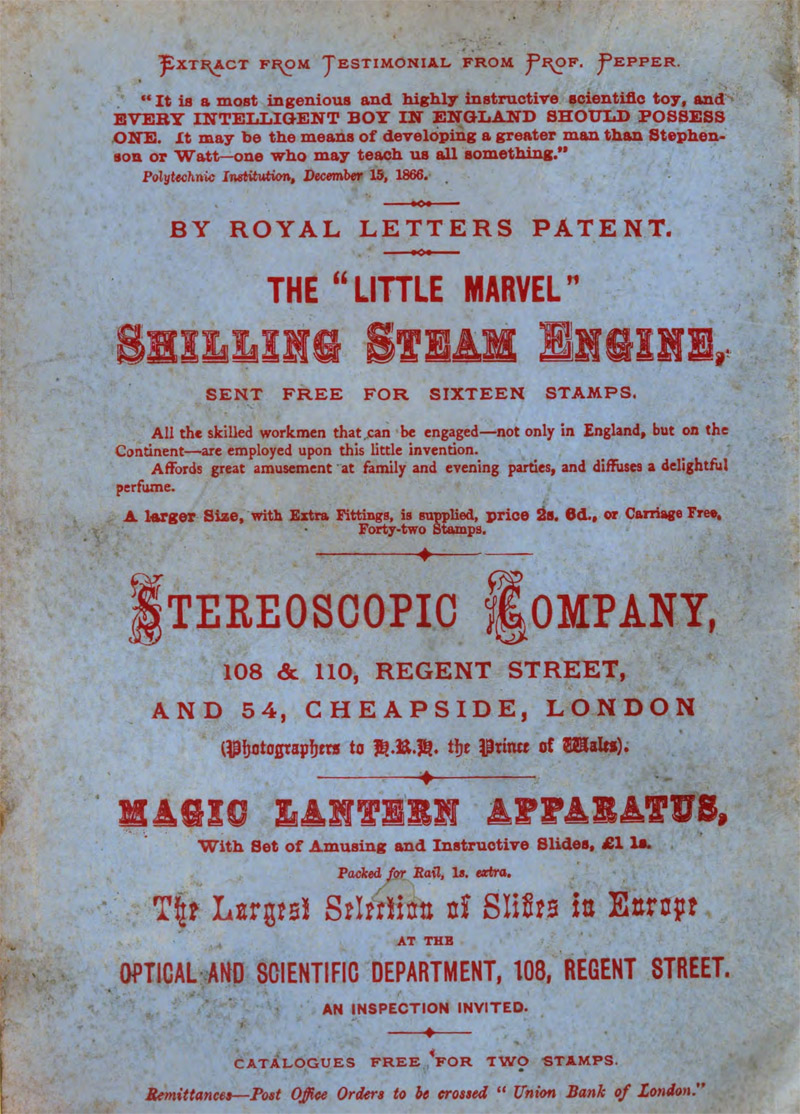
Figure 21.
LSC also sold toys, and exhibited them at international expositions. Advertisement from 1867.
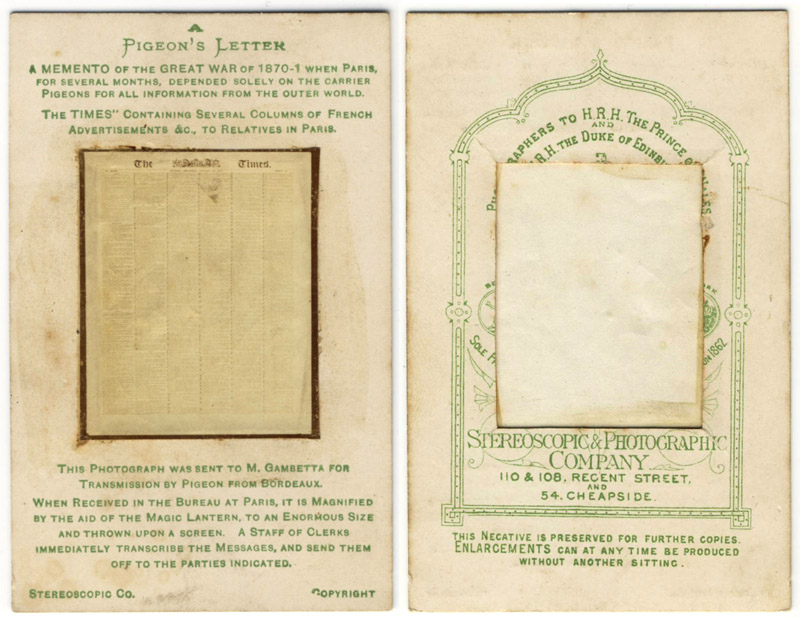
Figure 22.
Front and reverse views of a CDV-sized mount of a
“pigeon post” microfilm, purportedly from the siege of Paris during the
Franco-Prussian War. Images from internet auction site.
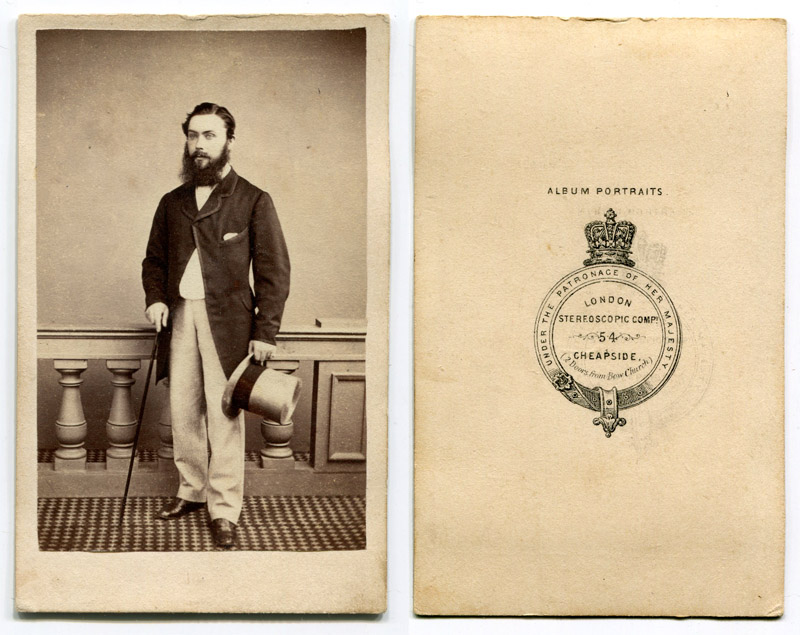
Figure 23.
CDV with the address of 54 Cheapside, dating it from ca. 1857-1862.
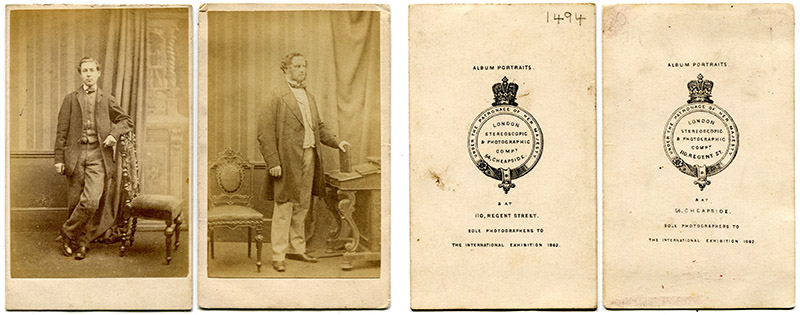
Figure 24.
CDVs with reverse insignia similar to that of Figure 23, but with the addresses of both 54 Cheapside and 110 Regent Street. One lists the Cheapside address within the circle, while the other lists Regent Street in that location, possibly signifying where each was produced (note, however, the same wallpaper and wainscotting in the background). The reverses also note that LSC was the photographer of the 1862 Exposition. These photographs likely date from 1862, since there are no indications of patronage by the Price of Wales, which began in 1863.
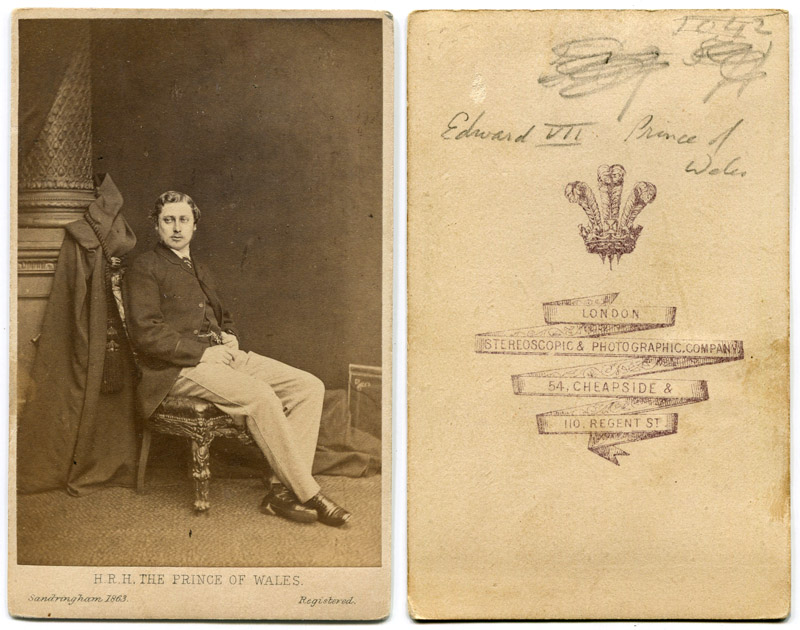
Figure 25.
A celebrity CDV, of the Prince of Wales (later King
Edward VII). The front indicates that the photograph was taken in 1863 at
Sandringham. The Prince also commissioned a series of stereoviews of
Sandringham (see Figure 26). The crown and feathers on the reverse are a symbol
of the Prince of Wales, and feature on LSC materials for many years afterward.
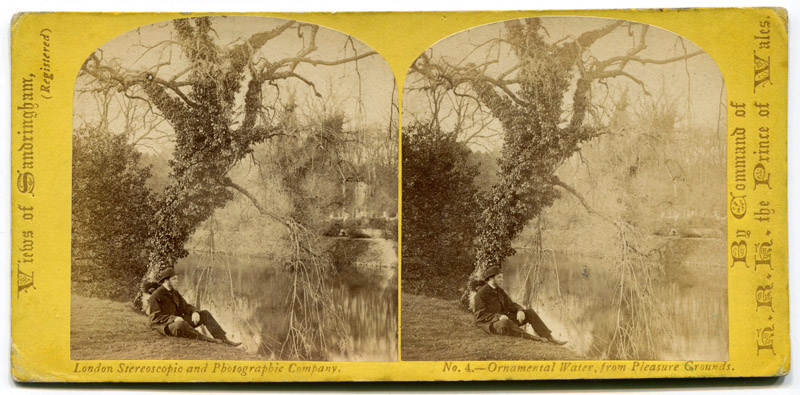
Figure 26.
Stereoview of Sandringham, circa 1863.
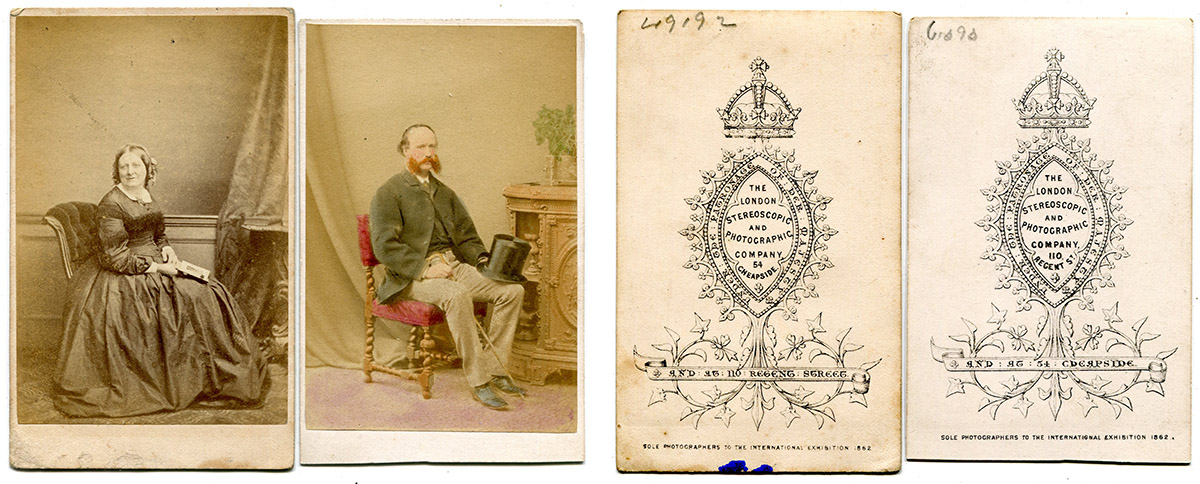
Figure 27.
Two CDVs with almost identical reverse patterns, except one lists the Cheapside address first, and the other lists Regent Street first. Presumably, the photographs were produced at the first-named location. Note the hand coloring on the right photograph.
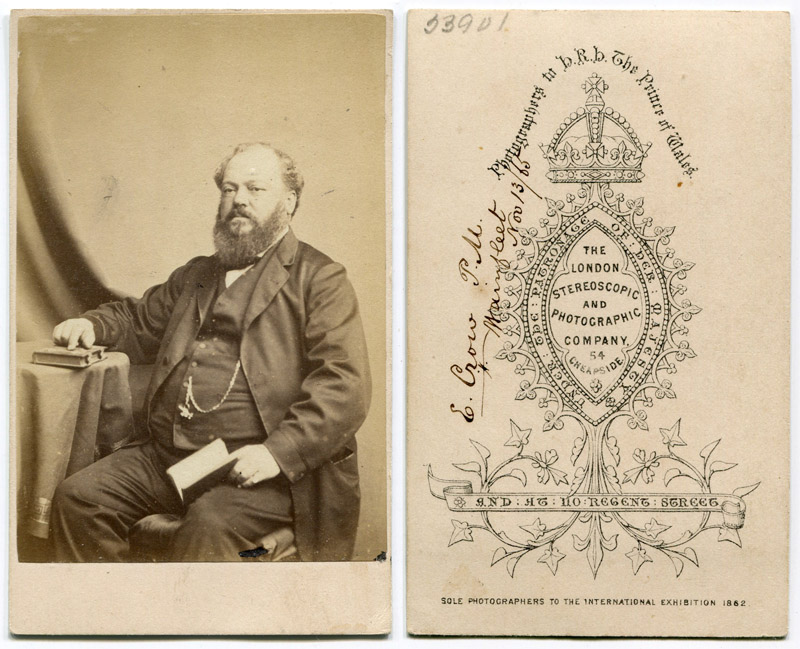
Figure 28.
CDV dated November 13, 1865. The reverse design is the same as those in Figure 27, with the addition of a banner stating ‘Photographer to H.R.H. The Prince of Wales’.
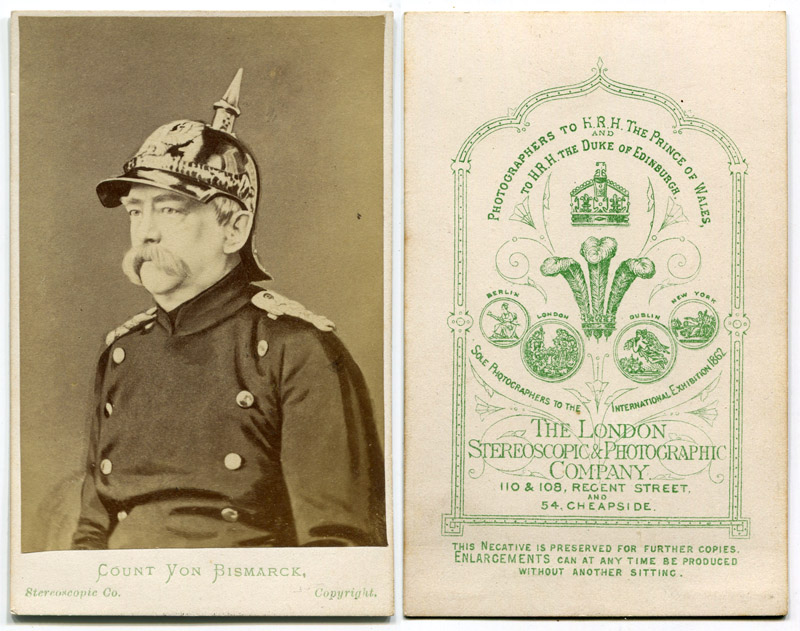
Figure 29.
Celebrity CDV of Otto von Bismarck, Chancellor of
Germany. The addresses of 110 and 108 Regent Street and 54 Cheapside are listed
on the reverse, dating the photograph to ca. 1866-1875.
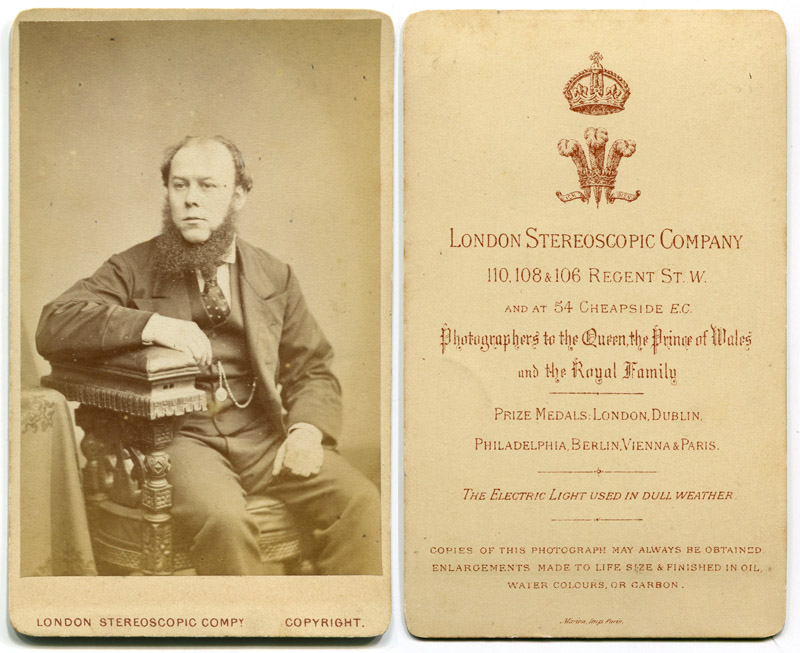
Figure 30.
CDV bearing the addresses of 110, 108 and 106 Regent
Street, and 54 Cheapside. The Philadelphia Exhibition noted on the reverse was
held in 1876.
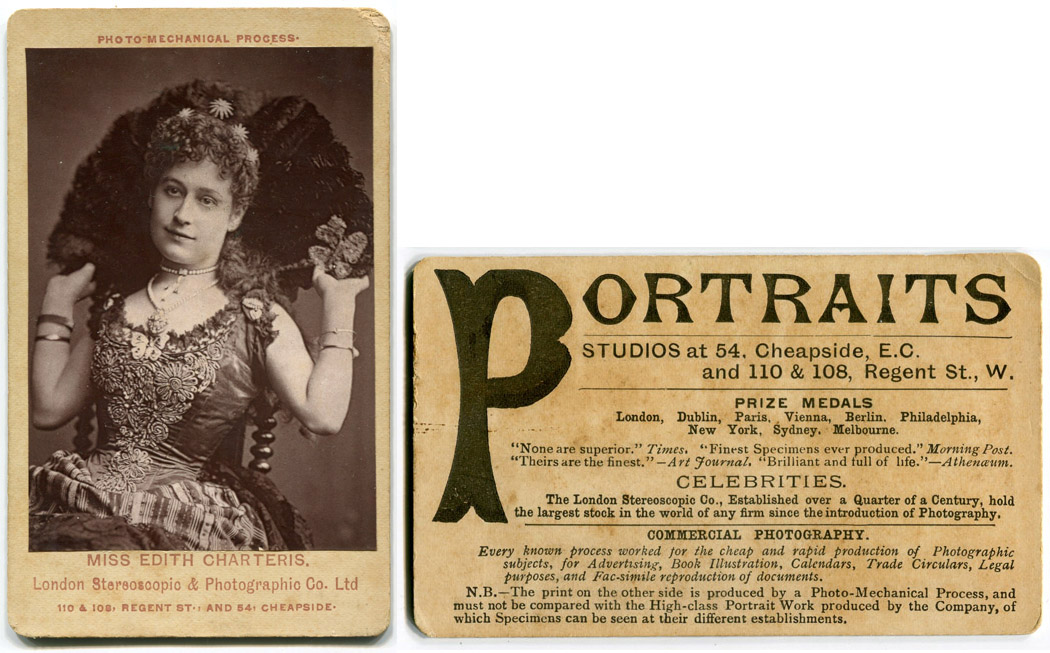
Figure 31.
Celebrity CDV of actress Edith Charteris. The
Melbourne Exposition noted on the reverse was held in 1881.
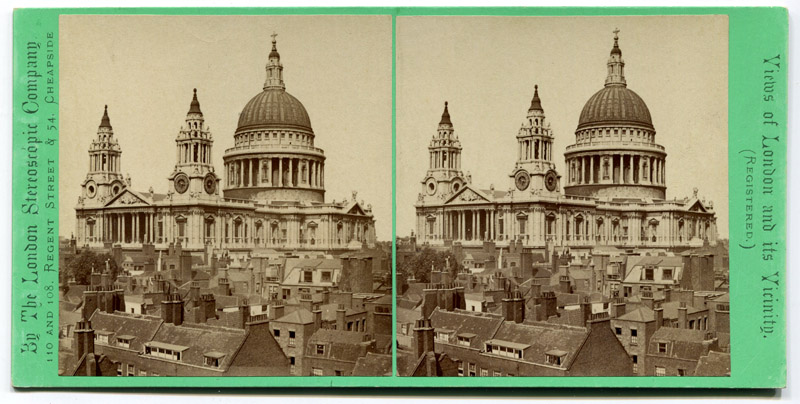
Figure 32.
Stereoview of Saint Paul’s Cathedral, over the rooftops of London.
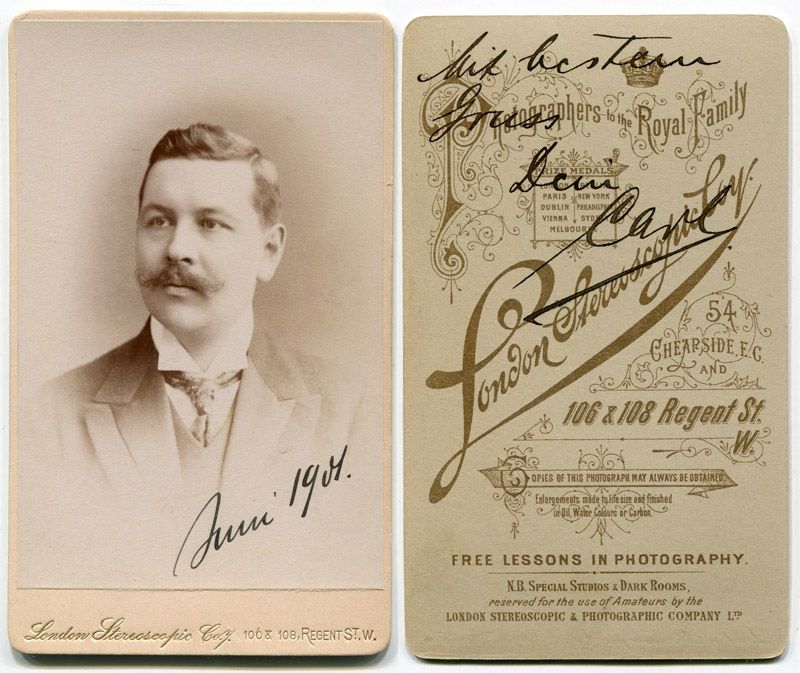
Figure 33.
A CDV dated 1901 and bearing addresses of 54
Cheapside and 106 & 108 Regent Street.
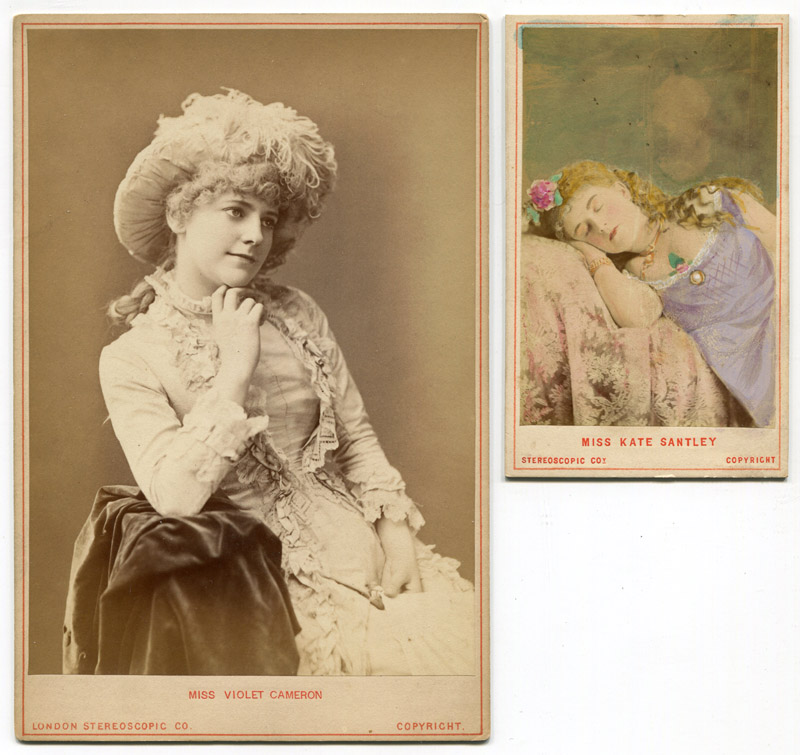
Figure 34.
A cabinet card and a CDV, with photographs of
actresses Violet Cameron (1853-1942) and Kate Santley (ca 1837-1923). The larger cabinet card became popular during
the early 1870s. Both have the same back image as does Figure 26, with the
addition of apparently recent prize medals: the cabinet card records a medal
from the 1873 Vienna Exhibition, and the CDV records a medal from the 1875
Vienna Exposition. The addresses on both are 110 & 108 Regent Street and 54
Cheapside.
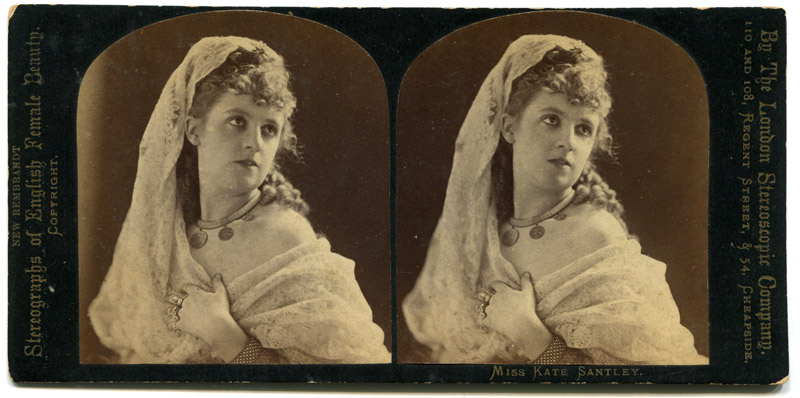
Figure 35.
Stereoview of “English Female Beauty” Kate Santley (ca 1837-1923).
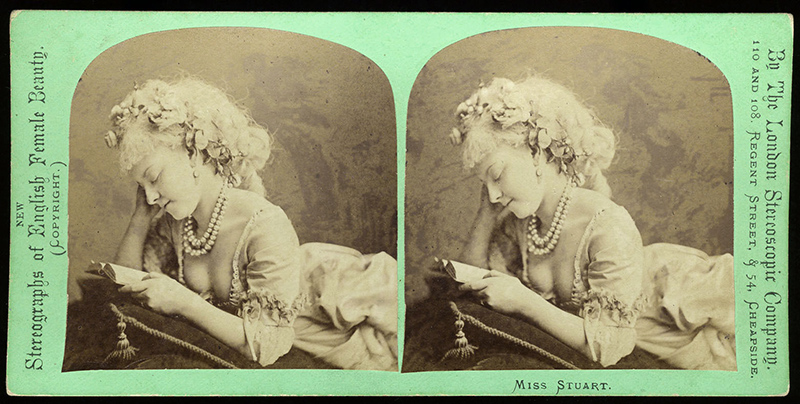
Figure 36.
A later stereoview of “English Female Beauty” "Miss Stuart". Adapted from an internet auction site for non-profit, educational purposes.
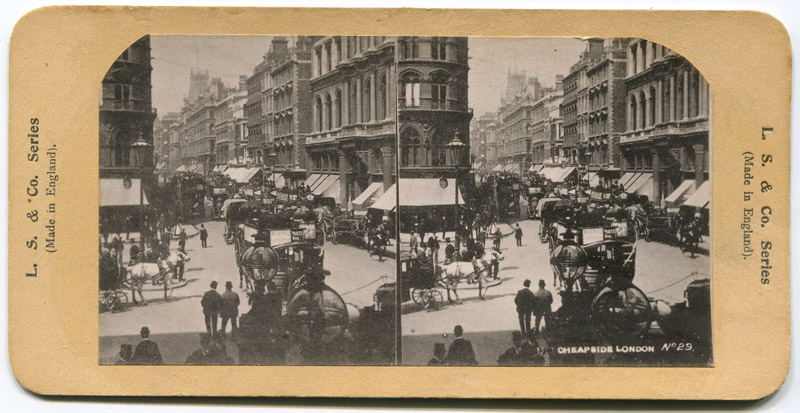
Figure 37.
Stereoview of Cheapside, dated 1907 in pencil on the reverse.
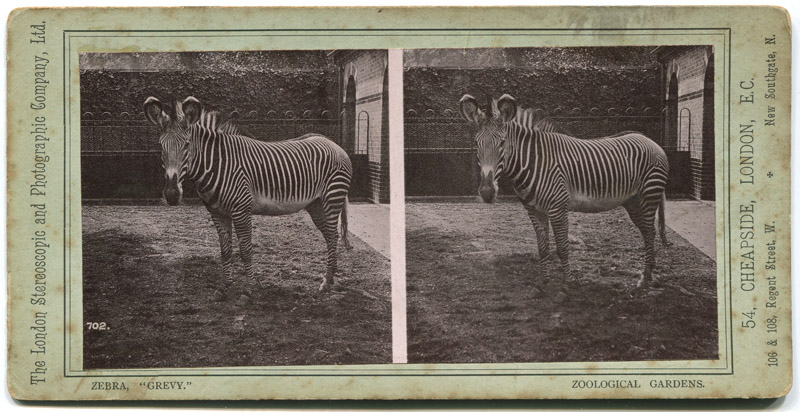
Figure 38.
Probably a fairly late stereoview.
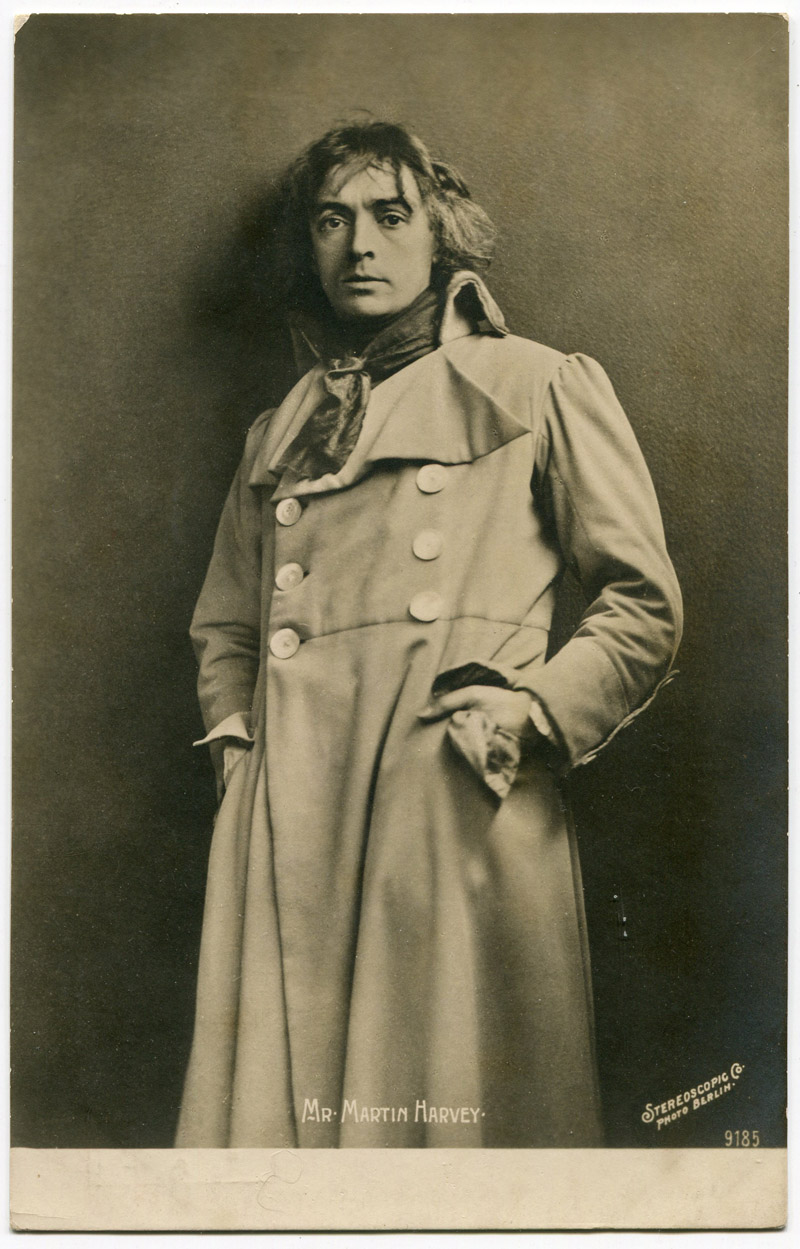
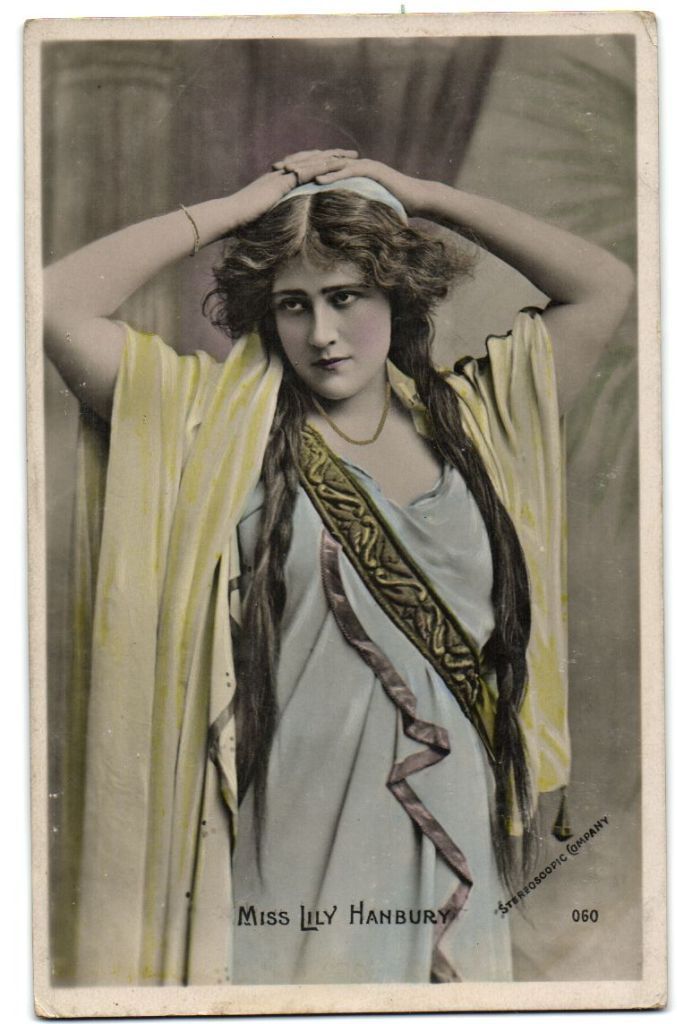
Figure 39.
Collecting photographic postcards of actors and actresses was a huge fad during the early decades of the 20th century.
Resources
The ABC of Modern Dry-Plate Photography (1886) London Stereoscopic Company, London
The Anglo-American Times (1866) Advertisement from the London Stereoscopic Company, Vol. 2, page 13
The Art Journal (1855) Improved stereoscope, Vol. 17, page 167
The Art Journal (1855) Advertisements from the London Stereoscopic Company, New Series, Vol. 2, January, February, July, and August Advertiser sections, first page
The Athenaeum (1861) Advertisements from the London Stereoscopic Company, Jan. 19, Feb. 16 and 23
The Athenaeum (1864) Advertisements from the London Stereoscopic Company, Nov. 19
The Athenaeum (1865) Advertisements from the London Stereoscopic Company, Nov. 11 and Dec. 30
Bracegirdle, Brian (1998) Microscopical Mounts and Mounters, Quekett Microscopical Club, London, pages 64 and 152 and plate 24N
The British Journal of Photography (1875) “Mr. George S. Nottage, of the London Stereoscopic Company, was on Wednesday elected an alderman of the city of London by a majority of thirty votes over Sir John Bennett”, Vol. 22, page 516
The Bookseller (1866) Advertisement from the London Stereoscopic Company, April 30
A Dish of Gossip Off the Willow Pattern, By Buz, and plates to match by Fuz (1867) Advertisement from the London Stereoscopic Company on rear cover, second edition, Laidlaw, London
Early Photography (accessed November, 2013) The London Stereoscopic and Photographic Company,
http://www.earlyphotography.co.uk/site/companies2.html
English Mechanic and World of Science (1885) Prospectus of the London Stereoscopic Company going public, Vol. 41, July 10, page v
Hardwicke’s Science-Gossip (1868) Advertisement for microscope slides of thallium platinocyanide
The International Annual of Anthony's Photographic Bulletin (1891) “Of hand cameras, the ‘Twin-Lens’ or double camera sold by the London
Stereoscopic Co. deserves high praise. It includes two identical and
rectilinear lenses; the upper one acting as a finder and showing an image on
ground glass of the same dimensions as the plate employed. Moreover, the two
lenses are focused together, so that as the operator focuses the picture on the
ground glass (which he can see), he also focuses it on the surface of the
sensitive plate (which he cannot see). This arrangement is excellent. The same
firm's ‘Artist's Camera’ is a capital hand camera lower in price than the
‘Twin-Lens’. Another useful novelty sold by the company, is Mason's Lantern and Table Microscope. This is a comparatively cheap instrument, which will either give a brilliant image on the screen when used with the oxy-hydrogen lantern, or can be used for photo-micro work, or as an ordinary microscope”, Vol. 4, page 425
The International Annual of Anthony's Photographic Bulletin (1891) A glimpse of commercial
photography, Vol. 4, pages 427-429
Journal of the Quekett Microscopical Club (1873) “The Annual
Conversazione of the Club was held, by the kind permission of the Council of
University College, in the Library and Museum of that Institution, on Friday
evening, March 21st, and was as interesting in the character of the objects
exhibited as on any previous occasion. It was attended by about 1,000 visitors,
amongst whom might be recognised many of eminence in Art, Literature, and
Science. By the kind assistance of a member of the Club, Mr. James Martin, of
the London Stereoscopic Company, the Soiree
Committee were enabled to exhibit a series of views by means of the
Oxy-hydrogen Light, illustrating the African Gold and Diamond Diggings, the
Victoria Falls, and some of the places intimately connected with the travels of
Dr. Livingstone”, Vol. 3, page 171
London
International Exposition Official Catalogue of the Industrial Department (1862) “Books &c.,
sold in the building, no articles are sold under authority of Her Majesty’s
Commissioners except the following … Photographic views of the Exhibition, by
the London Stereoscopic Company, at various prices”, Her Majesty’s
Commissioners, London, page 11
(Modern) London Stereoscopic Company, Ltd. (accessed November, 2013) http://www.londonstereo.com/index.html
May, Brian and Elena Vidal (2009) A Village Lost and Found, Frances
Lincoln, London
Nature (1908) Advertisement for London Stereoscopic Company
camera, Vol. 22, page cclxiv
Notes and Queries (1855) Advertisements from the London Stereoscopic Company, October 20 and 27
Notes and Queries (1858) Advertisements from the London Stereoscopic Company, Series 2, Vol. 5, May 15 and 22 advertisement pages
Palmquist, Peter E., and Thomas R. Kaliboum (2000) Pioneer Photographers of the Far West, Stanford University Press, Redwood City, California, page 374
Payne, Brett (accessed November, 2013) Victorian & Edwardian Photograph Collection: The London Stereoscopic & Photographic Company,
http://freepages.genealogy.rootsweb.ancestry.com/~brett/photos/eng/lon/londonstereo.html
PhotoLondon (accessed November, 2013) George Swan Nottage,
http://www.photolondon.org.uk/pages/details.asp?pid=5707
The Photographic Journal (1861) Correspondence: “Sir, In your recent review of our series of American scenery, you express regret that the name of the clever artist who produced the series has not been given. We have much pleasure in informing you that the name of our artist is Mr. William England, whose connexion with our establishment dates from its commencement. We may also mention that this gentleman is the artist of our new series of 'Instantaneous Views of Paris,' which are at the present moment exciting so much interest and admiration in that city. George S. Nottage.”
The Photographic News (1858) Advertisements from the London Stereoscopic Company, Vol. 1, Nov. 19 and other issues
The Photographic News (1877) “Mr. Alderman Nottage
(of the London Stereoscopic Company) was, a few days ago, elected one of the
Sherriffs of the city of London for the ensuing year”, Vol. 21, page 311
Photographic Notes (1857) Advertisement from the London Stereoscopic Company, Vol. 2, page 71
The Publishers’ Circular (1861) Advertisement from the London Stereoscopic Company, Vol. 25, page 72
The
Railway News (1896) “The death of Mr. Howard John Kennard, after a short
illness, took place at the Orleans Club, at Brighton, on Saturday last, in his
sixtyseventh year. The deceased was the son of the late Mr. R.W. Kennard, M.P.,
for Newport, Isle of Wight, and grandson of Mr. John Kennard, banker of Lombard
Street. He was chairman of the Blaenavon Iron company, partner in the Falkirk
Iron company, a Justice of the Peace for Stirlingshire, one of Her Majesty's
lieutenants of the City of London, deputy-chairman
of the Northern and Eastern railway, a director of the Great Eastern railway, a
past master of the Carpenter's company, and President of the Royal Metal
Trades' Pension society. With Mr. Alderman Nottage, a
late Lord Mayor of London, he established the London Stereoscopic company. He was also a M.I.C.E. and
M.I. and S.I.”, Vol. 66, page 293
Royal Academy of Arts Collections (accessed
November, 2013) The London Stereoscopic and Photographic Company,
http://www.racollection.org.uk/ixbin/indexplus?_IXACTION_=file&_IXFILE_=templates/full/person.html&_IXTRAIL_=Names%A0A-Z&person=11416
Solomon, Joseph Isaac (1887) Recollections of early days in
photography, The
Photographic Times and American Photographer, Vol. 17, pages 374-375
Spitalfields Life (accessed April, 2014) http://spitalfieldslife.com/2012/11/23/the-streets-of-old-london/








































